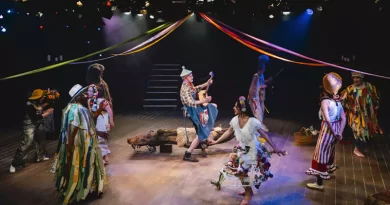“What Was Shakespeare Really Like?” by Stanley Wells
Book review by Simon Jenner
3 December 2023
Now 93, pre-eminent Shakespeare scholar Stanley Wells has recently written several short works on Shakespeare. What Was Shakespeare Really Like? distils this further, even discussing what used to be called the fruitlessly speculative.
Drawing on four lectures delivered during the early part of Lockdown in 2020, Wells crafts an interrogatory volume around four key questions. He both expands on the originals, and tops with an introduction, prefaced with a foreword by Stephen Fry.
To conclude, Wells gives us a lengthy apologia for his own life in Shakespeare: ‘Epilogue: Eight Decades with Shakespeare – and More’. It’s a potted academic autobiography, a career solely dedicated to Shakespeare from Wells’s time at Birmingham University onwards.
Wells delights in dismissing certain academic projections, and proves once again fresh and challenging. Thus his book plays with four questions about Shakespeare: “What Manner of Man Was He?” “How Did Shakespeare Write a Play?” “What Do the Sonnets Tell Us about Their Author?’ “What Made Shakespeare Laugh”. In this, he turns matters on their head and asks what Shakespeare thought would make us laugh.
Each are differently structured, and come with copious black-and-white illustrations – including meditations on recent portrait evidence (the Cobbe). The second chapter on playwriting has many short subsections, and the third is an essay on a single genre (the Sonnet) that probes identity too. Above all Wells projects Shakespeare the company man in those chapters dealing with life and playwriting; as well as the personal self-torturing writer of sonnets he never intended for publication.

Cobbe portrait, a Jacobean panel painting.
Possibly a portrait of Shakespeare.
II
The first chapter deals with Shakespeare’s origins, schooling and the data we have. After the usual bare facts (including the number and manner of players’ companies arriving at Stratford during Shakespeare’s early life), Wells looks at the evidence: with Shakespeare’s likely professional trajectory towards London he dispenses with the speculative. Thus school-mastering or service with a great family isn’t toyed with. Wells cuts to a stark evidential thread: that Shakespeare hitched to a theatrical company.
Wells takes in the dramatist’s capacity for sheer hard work, his absorption of many books, speculating where he wrote his plays based on such a bulky acquisition. It’s a shrewd surmise that Shakespeare’s will bears out: at home. As Wells says (p. 107), Shakespeare was both the least London-centred dramatist of his time, and the first writer to commute.
Shakespeare rented rooms in London but never till towards the end invested in property there. From this, Wells argues that Shakespeare used New Place back at Stratford to write where many books were in reach, which would not have been the case in a small London room.
There is also the way the impress of books worked on the dramatist’s mind; how this shifted over 20 years. Shakespeare used less Latin as he progressed and became more confident as conventions shifted, partly as a result of the impact of his own work.
Wells sees Shakespeare as “essentially a modest man, even humble, unflamboyant in his way of life, lacking personal vanity. His genius was at the service of his art” (p, 105). Also a family man, deeply attached too to Stratford though he never took part (unlike his father) in its public affairs, despite being its richest resident.
Wells too highlights a gift for collaboration, balancing both different egos and retaining all sorts of information. He reminds us that Shakespeare never repeats himself even though winning formulas were tempting; while pleasing fellow actors and men (always men) of theatre.
And Shakespeare’s lack of interest in seeing his dramatic works in print by contrast with Jonson whose own 1616 Works inspired Shakespeare’s colleagues to do the same for him. There is a point where speculation on this reluctance – humility, perfectionism, a sloughed process and last week’s play – becomes fruitless.
Shakespeare’s time at Silver Street lodgings, involving a pair of lovers is touched on. It’s spawned a book (Charles Nicholl’s The Lodger, Allen Lane 2007), but here a few lines suffice.
Another writer, the late Katherine Duncan-Jones, is both quoted approvingly and where they have publicly disagreed, or where she concedes over the Cobbe portrait that Wells champions: “as even the most adversarial of critics…” (p. 134) is then slyly recruited to Wells’ argument.
Nevertheless, he gives Duncan-Jones credit where it’s due over Shakespeare’s land acquisition (p. 24), and more equivocally over the same discussion (pp. 4-5). He lists her Ungentle Shakespeare (Arden 2001 rev. ed. 2010) in a revealingly short bibliography of essential reads – and a separate generous one for himself. And as he notes, there’s always Philomena Cunk.
Wells also observes that despite his many gifts to friends, families and the poor in his will, Shakespeare was at the end of his life protecting his own land against incursions: family ties win out over altruism. It spawned Edward Bond’s play Bingo in 1974.
III
For those who don’t know Wells, his radicalism is worth summarizing. It’s included in these pages too. This is the scholar who with his Oxford Edition (completed in 1986, revised ed. 2005) introduced co-editor Gary Taylor’s (not new, but reinvigorated) thesis that young City satirist Thomas Middleton collaborated with Shakespeare on Timon of Athens in 1605-06.
In their 2005 edition, Wells and Taylor went further. Middleton around 1621, five years after Shakespeare died, collaborated posthumously as it were. Middleton seems likely to have cut down Macbeth, and added a few witch scenes. Tragedies, Wells notes, are usually much longer than comedies and the anomalous Macbeth is a very short play.
Further, Taylor asserts that Middleton altered Measure for Measure (c. 1604) – to the extent of moving it from Verona (again!) to the illogical Vienna with its Italianate names intact and adding brothel scenes.
To this 2005 edition Edward III – written largely by a plotter of genius, Thomas Kyd, but with more ascribed to Shakespeare than we thought – is added to the canon (Cambridge University Press were quick to publish it as a single play). On the partially-reconstructed Cardenio, however, despite the Arden Edition’s attempts in Double Falsehood in 2010, Wells remains silent.
IV
Wells here also reflects that Shakespeare was both fluid in genre and roughly divided as was then the custom, long tragedy and short comedy. The 1623 Folio editors Condell and Heminge introduced new genres (like Histories) and broke Shakespeare up into the conventional five acts – something Shakespeare, unusually, never bothered with, as witness the Quartos.
What Wells here also establishes then is Shakespeare the shapeshifter, whose work practices were the opposite of say Ben Jonson’s classicism. Both act division and genre observance were uniquely alien to Shakespeare.
Wells here goes further than his latest Oxford edition. He asserts that older dramatist Thomas Lodge was co-author of Titus Andronicus, and he may have other thoughts about the three-part Henry VI (Marlowe as one collaborator was mentioned by Taylor) though in this book he does not enter into such discussions except those summarized above.
All this of course also feeds directly into what Wells thinks of Shakespeare’s collaborative curve. That from roughly 1590 when his first solo-authored play The Two Gentlemen of Verona was written through to around 1594, Shakespeare largely collaborated; not always but generally.
Then from 1594-1604, Shakespeare solely authored plays, was at the top of the theatrical profession as co-owner of the most prestigious company and its pre-eminent dramatist: collaborating, discussing, setting to work. Wells is sensibly persuasive. One imagines him transposing various board meetings of his own onto how he imagined Shakespeare worked, with due nods to period. And it’s no bad fit.
V
Finally, Wells addresses that though far from waning creatively as a writer, Shakespeare’s creative impulse probably waned somewhat, and he began to collaborate again. Particularly as he saw new dramatists, notably the very different Middleton, succeed with city comedies, a genre Shakespeare never much liked.
Or indeed Fletcher with Romance: Shakespeare was never above taking hints. His own ‘Late Comedies’ or ‘Romances’ certainly took in both Fletcher’s work, and the new indoor Blackfriars theatre’s intimacy with select theatregoers: more educated, more interested in close-up, intricate entertainment. Wells notes too that unlike Jonson for instance, Shakespeare never wrote masques for his ultimate patron, James I.
Thus from Timon of Athens we can see a series of late collaborations, with the scurrilous sea captain George Wilkins for Pericles, and notably John Fletcher for a trio of late plays: Henry VIII, Cardenio, The Two Noble Kinsmen, the last finally taken into the canon 40 years ago (notably by Penguin), as was Pericles by the 1660s.
Being Wells, there is a bit of point-scoring but considering it’s about how we read Shakespeare it’s worth repeating here. Wells has much to say on how his Penguin then Oxford Editions updated and made Shakespeare accessible. Gone is the “wayward” Cambridge Edition of John Dover Wilson as Wells terms it, the stuffy dry-dust Arden (1st Edition 1896-1944, 2nd 1946-82) and its starting with date ascription inducing yawns and oblivion (it didn’t with me, but I take Wells’s point).
Wells was the first to introduce theatrical practice in his editions. The Third Arden edition (1995-2020) certainly benefits from performance practice and even more recent scholarship on gender fluidity, world theatrical interpretations, Queer Theory and historical and recent performance examples.
VI
But above all, Wells asks human questions, and with him are the humanist approaches of Harold Bloom and Martin Seymour-Smith. He would not thank me for saying that, but it’s true. Gone are the structuralist essays on Sonnet 144 (Jonathan Cullers, 1974, where barley-break references are forbidden); even post-structuralist slippages, readings of sonnets as the grammar of a courtly glass-bead game of the 1980s and 1990s.
Wells cites Duncan-Jones again on page 77 while wrangling with many about the publication of the Sonnets. He disagrees with some (like Duncan-Jones) who declare Shakespeare handed the Sonnets over to printer Thorpe in 1609, some years after the last had been written (Wells suggests a last burst from 1600-04).
In this he agrees with an old sparring-partner, Martin Seymour-Smith, whose own pioneering original-spelling and punctuation edition of the Sonnets (Heinemann, 1963) wholly agrees with Wells on two points. That the sheer explicitness of the Sonnets argues against Shakespeare having wanted them in the public domain. His own sexuality, as well as promiscuity, was now on show: one was embarrassing to say the least, the other potentially fatal.
The other area cuts through the genteel homophobia of so many academics till recently. If Seymour-Smith was the first to openly discuss Shakespeare’s bisexuality while homosexuality was still illegal, it’s taken until very recently – with the work of Alan Sinfield and Jonathan Dollimore at Sussex – for Queer Theory to emerge; and mainstream scholarship to hesitate approval.
Wells though will not follow the radical politics of these authors’ collaborations, let alone Sinfield’s Shakespeare, Authority, Sexuality: Unfinished Business in Cultural Materialism (2006). He shows no interest in such radical revisionism, reading Shakespeare against himself, and so on.
Wells like Seymour-Smith has no such qualms over discussing Shakespeare’s sexuality though; and proves another pioneer deserving credit for proclaiming it to a point others develop. Wells brilliantly dissects the diarist Meres who refers as early as 1598, at the end of the sonnet boom, to Shakespeare’s “sugar’d sonnets … amongst his private friends”. “Sugar’d” is a loaded homoerotic word. Wells is the first scholar to my knowledge to discuss this coding.
It’s a pity these two great scholars sparred. The spiky Seymour-Smith was irritated, with reason, that Wells did not cause single volumes of the plays to be released in the original spelling: it would have rendered the Oxford Edition unique. I was tasked with quizzing Wells on this point when we met, and Wells’s airy dismissal that students could purchase the entire old-spelling volume (£75 was too much for most of us in 1989) was Seymour-Smith’s point.
Nevertheless, we’re in a new age of academic humanism. Bloom’s Shakespeare: The Invention of the Human in 2004 might go too far for some, though that and the occasional work of Seymour-Smith (whose old-spelling edition of the Sonnets remains ground-breaking as does his 1998 one of the other poems) is far closer to Wells than John Carey, whom Wells brings out as imagined straw adversary. Quoting (on p. 110) Carey’s recent Little History of Poetry (2020) he skewers Carey’s assertion that Shakespeare “spent his life making up speeches for imaginary people, and this is what these [sonnets] probably were.”
Citing his arguments, Wells concludes Matthew Arnold-like: “I disagree. I am with Wordsworth, who wrote ‘with this key/Shakespeare unlocked his heart.’” (p. 110).
He is also with Seymour-Smith who wrote even more movingly: “There is nothing like this in literature …” Yet as Seymour-Smith declares: these poems don’t dwell on personality or performative delight (essential to the fashionable sonnet sequences and even games of the 1590s, and thus some academics) “His poems transcend this. His poems say, instead. ‘Look at you!’” Seymour-Smith remains for this writer the most profound scholar on the Sonnets, and it’s interesting, revisiting the latter’s text, to see them agree on so much.
Except, perhaps, Wells’s tinkering with the order of sonnets in his edition with Paul Edmondson (OUP 2004). There’s a perennial compulsion in some to craft a more ‘satisfying’ reading sequence, a meddling pursued through the twentieth century. We know the last two sonnets (153 and 154) are exercises (Wells suggests as far back as Shakespeare’s schooldays); and the broad division is accepted. But having noted this in an Introduction, Wells could leave it there. Still, if pushed, I should prefer Wells and Edmondson’s re-ordering to anyone else’s.

Paul Edmondson and Stanley Wells’s edition of the sonnets.
VII
Wells’s discussion on “What Made Shakespeare Laugh” is quite brief, 16 pages, and reveals two things. That Wells does not quite know, and that he feels Shakespeare’s bent before Hamlet was essentially comic. That even this period was divided into two halves, where the latter draws a potentially irredeemable villain to be punished (Shylock, Don John) or appeased (Orlando’s brother Oliver, Malvolio). After Hamlet “comic antagonists become more morally complex, more threatening, less easy to identify” (p. 96). Bloom thought Shakespeare’s muse essentially comic; the two views are not incompatible. Wells thus concentrates on pre-Hamlet plays in discussing humour.
Wells is on surer ground in pointing up where he feels Shakespeare, even early on in The Two Gentlemen of Verona, knows how to create ‘groan’ jokes, as in the exchange between two servants Lance and Speed punning around “stand”. “Shakespeare himself may have groaned as he wrote it” (p. 97). Commentary strengthens through the more complex and underrated The Merry Wives of Windsor, and flourishes on the bawdy in Dogberry’s pomposity and unwitting bawdy in a series of “ass” jokes. Indeed, sex charts the development of humour through Hamlet’s “country matters’ through to Lear’s Fool and his bitter jibes through to Cleopatra’s “Husband, I come” (p. 99).

Shakespeare and Co. was published in 2006.
VIII
Late style often goes one of two ways. To the abrupt and experimental, as Edward Said and Theodore Adorno discuss – with Beethoven, Shakespeare or Michelangelo. Or to quintessence and distilling a lifetime into a serene order like Verdi or Monet. Wells himself straddles both: he is wonderfully puckish and disruptive, but he has always been like that; in person too.
But he is also deeply humane, takes risks (he knows he takes them and delights in doing so) but overall remains the most informed, persuasive scholar now writing on the bewitching, troubling mask of Shakespeare. It seems we can never let the writer alone to speak through that mask in his own words, and leave him there.
Wells, in what might prove his final book, uses those words only so far as is reasonable, but pursues their implications – in the Sonnets – with a clear-eyed refusal to water them down. Polite excuses of ‘Elizabethan friendship’ are laid to rest, though simmering misogyny is not probed. Wells’s sifting of the latest factual scholarship is exemplary: its scaffolding frames the inner life he convinces us we see, through flashes of lightning, fourteen lines at a time.
Cambridge University Press 2023 149 pp £14.99
To order from Cambridge University Press Bookshop. (Usually delivers free within UK.)









